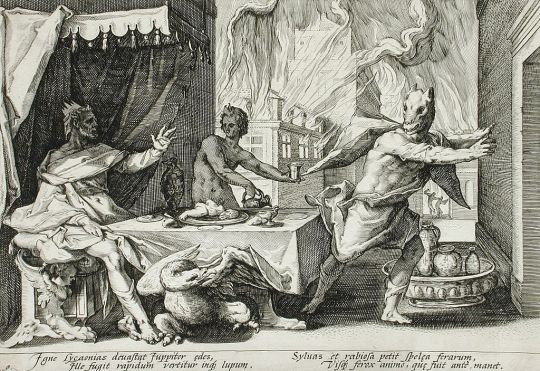The “First” Werewolf

Throwing something like “the first werewolf” out there is a very big statement. We know werewolf beliefs existed well into pre-history – BC or CE depending on how you want to list your dating system. We have cave paintings from around 45,000 BP (Before Present; radiocarbon dating system) or so. So who or what was the “first werewolf?” We can’t really know. That’s lost to time. To claim otherwise is ridiculous and false.
Depending on what scholar you ask, though, you might get some different answers. But when it really comes down to it, in terms of what we think of as a werewolf today, who was the first recorded werewolf? Probably King Lycaon of ancient Greece. Pop culture has latched onto this idea, too – just ask Teen Wolf (the MTV show, not the original movie).
So what’s the deal with King Lycaon, anyway? Here’s how his story goes:
The Greek king named Lycaon ruled over the region of Arcadia, which is often considered a pastoral paradise, at least in Early Modern culture. Although most scholars refer to the version of this tale as retold in Ovid’s Metamorphoses, many variants of Lycaon’s story exist, one of which – told by the Greek poet, commentator, and grammarian Lycophron – says that Lycaon, as well as all his sons, and even all the other people of Arcadia were turned into wolves.
Ovid, however, tells a different tale: Lycaon doubts the divinity of Zeus when the god visits Arcadia. In order to test Zeus’s divinity, Lycaon attempts to feed him cooked human flesh and have him assassinated in the night. When Zeus realizes what Lycaon is doing, Lycaon tries to flee in fear.
But as he runs into the fields of Arcadia, trying to escape Zeus’s wrath, Lycaon is transformed into a wolf.
So just like Lycaon is possibly the first werewolf we still have on record, he’s also an early example of involuntary transformation with negative connotations. He even has his own detailed shift into his wolf form! Witness history’s first werewolf transformation sequence, as recounted by Ovid:
[Lycaon] howled his heart out, trying in vain to speak.
With rabid mouth he turned his lust for slaughter
Against the flocks, delighting still in blood.
His clothes changed to coarse hair, his arms to legs—
He was a wolf, yet kept some human trace,
the same grey hair, the same fierce face, the same
Wild eyes, the same image of savagery.
King Lycaon’s change, unlike some werewolves, seems to be permanent – although this wasn’t the case with many of the later tales of Arcadian werewolves, of which there are lots, and werewolves became adopted into their very culture (more on those later). There are werewolf tales as told by Greek and Roman authors such as Virgil, Herodotus, Pliny, Petronius, and many others, including Pomponius Mela and Agriopas.
Plenty of them are not necessarily considered a curse like Lycaon’s was.
King Lycaon is by no means the only werewolf of ancient Greece. I’ll cover all the others in the future. The Arcadians (the people of the land King Lycaon ruled) themselves were very heavily associated with werewolves and had lots of werewolf rituals, which will be the focus of another random werewolf fact. Same goes for Roman werewolf beliefs.
So if you didn’t think the ancient Greeks believed in werewolves, now you know – they certainly believed in them, and they had plenty! Not all of them were considered curses and/or malevolent like Lycaon, either.